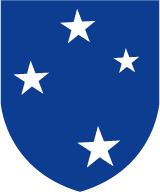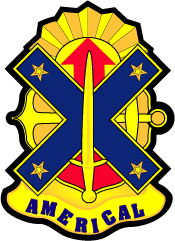 Description:
On a blue Norman shield 2 5/8 inches high and 2 1/3 inches wide, four white stars of varying sizes all slightly tipped to the dexter, arranged to represent the Southern Cross.
Symbolism:
The four white stars on the blue field are symbolic of the Southern Cross under which the organization has served.
Description:
On a blue Norman shield 2 5/8 inches high and 2 1/3 inches wide, four white stars of varying sizes all slightly tipped to the dexter, arranged to represent the Southern Cross.
Symbolism:
The four white stars on the blue field are symbolic of the Southern Cross under which the organization has served.The Naming of the Americal Division is also unique. It was named as a moral boster to it's troops before moving on to be the 1st Army Division to see combat in WWII. HEADQUARTERS UNITED FORCES IN NEW CALEDONIA 27 May 1942 GENERAL ORDERS) NO ………………10) 1. Pursuant to instructions contained in War Department, radiogram, dated 26 May 1942, and under authority of letter AG 320.2 (5-23-42) MR-M-OSD, Subject: Constitution and Organization of Americal Division, dated 24 May 1942, the United States Army Forces of this Command ave been constituted The Americal Division, without a numerical designation. 2. The name "Americal" was proposed by Private 1st Class David Fonseca, 26th Signal Company and was recommended by this headquarters to the War Department as the name desired. By command of Major General PATCH: E. B. SEBREE Colonel, G.S.C., Chief of Staff
"The name ‘Americal’ was submitted April 23, 1942 and officially recognized by the War Department May 27, 1942. The name AMERICAL was submitted because we were organized as a Division in New Caledonia, denoting, Americans in Caledonia. We are the only Army Division without a numerical designation.
" Sgt. David Fonseca, letter to Liberty Magazine, January 18, 1944
 After a tour of duty Americal Veterans were allowed to wear this patch on the right shoulder for the rest of their career a prestigious symbol in the US Army. Below a short history of US Army patches.
After a tour of duty Americal Veterans were allowed to wear this patch on the right shoulder for the rest of their career a prestigious symbol in the US Army. Below a short history of US Army patches.
During the Revolutionary War, George Washington devised badges so that rank might be readily identified, as the Revolutionary Army did not have any uniforms. Washington's order directed what color of ribbon and where it was to be worn so everyone could distinguish the rank of each solider. Since that time, military insignia has multiplied according to the needs of each branch of service.
Shoulder sleeve insignia apparently originated during World War I. Many were cut out patches of felt, applied on a background. The more modern patches are of embroidery. Some of the early patches of World War II were hand embroidered. This is especially true of Navy ratings. The patches manufactured today are machine embroidered. The brightly colored insignia, worn on the left shoulder, denotes the command unit under which a solider serves, and serves the purpose of the enameled badges of the Civil War and Spanish-American War.
The first shoulder sleeve insignia is credited to members of the 81st Division. On their way to France in 1918, the unit adopted the figure of a wild cat, and was granted permission to wear it in October of 1918. Because General Headquarters recognized the value of a patch as a means of building moral and helping troops assemble under their own officers, all organizations of the American Expeditionary Force were directed to adopt similar insignia.
Most of the insignia used by the US Army are based on historic facts or on some attribute of the organization concerned. Certain specific rules apply to the design of insignia. The United States armed forces follow the laws of heraldry. Thus, no part of the coat of arms of the United States or any complete arms, seal, or flag of any State or other country may be used. All symbols, whether animals, birds, or inanimate objects, must face the honorable (right or Dexter) side, or appear in full face.
This is a carry over from the Middle Ages, when a knight defended with the sword in his right hand. After World War II, the wear of a unit patch on the right shoulder was approved to denote service in combat with that unit. A new design must not conflict with an existing one, nor may it resemble too closely a symbol employed by the enemy. The insignia for the 45th Division was changed in 1939 from an Indian Swastika on a red square to the Thunderbird for this reason. Instant recognition of the insignia is essential. Many of the patches originally approved have had minor modifications made over the years and later been re-approved.
 Description:
Description:A gold colored metal and enamel device 1 3/8 inches in height overall, consisting of a blue saltire bearing four white stars one near each end, and centered vertically thereover a gold sword with hilt in base upon a red field edged with gold and behind the sword point at top a red arrowhead point up upon the center of a gold radiant sun, and centered horizontally with shank passing behind the saltire a gold anchor with crown at left and ring at right with cable passing through and behind the arms of the saltire; all above a gold scroll inscribed "Americal" in blue.
Symbolism:
The saltire alludes to New Caledonia in the Southwest Pacific where the division was first activated on 27 May 1942, and with its blue color (for infantry) and four white stars forms a "Southern Cross" and refers to the division's shoulder sleeve insignia and the area in which the division initially served. The four stars (the brightest in the Southern Cross constellation) also allude to the four campaigns of World War II in which the division participated. The anchor refers to the Presidential Unit Citation (Navy) awarded the division for Guadalcanal, and the red arrowhead and Phillipine sun for the assault landing in the Southern Phillipines and the award of the Phillipine Presidential Unit Citation. The unsheathed sword with point to top refers to service in Vietnam. The division is one of the few within the U.S. Army to bear initially a name instead of a number, and former designation "Americal" was adopted as a nickname, the association being both inspirational and historically significant.

Decorations
